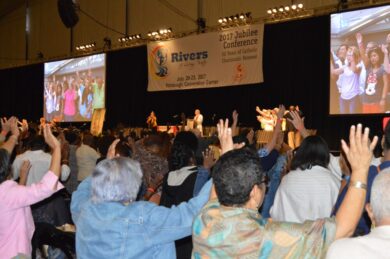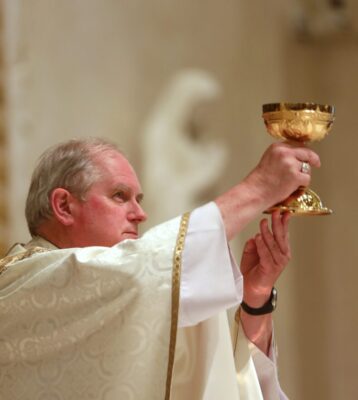April 18, 2024
Bishop: Catholic charismatic renewal creates ‘church on fire’ with God’s love
NATIONAL
By Gina Christian, OSV News

People pray July 20, 2017 during the Catholic Charismatic Renewal’s 50th Jubilee Conference at the David L. Lawrence Convention Center in Pittsburgh. (CNS file photo/John Franko, Pittsburgh Catholic)
(OSV News) — The Catholic Church’s charismatic renewal is a movement of the Holy Spirit to “bring about a church that is on fire” with God’s love, the bishop newly appointed to serve the Holy See’s official charismatic body told OSV News.
“The Catholic charismatic renewal … is a deeply personal, life-giving, ongoing, transforming encounter with the Trinity — God the Father, Son and Holy Spirit. Often it’s (a particular encounter) with the person of Jesus,” said Auxiliary Bishop Peter L. Smith of Portland, Oregon. “And then from there, the empowering of the Holy Spirit … in a radically new way transforms (the) life of faith.”
In February, Bishop Smith was appointed the new ecclesiastical assistant of CHARIS, the Catholic Charismatic Renewal International Service, inaugurated by the Holy See on Pentecost in 2019 through the Dicastery for the Laity, Family and Life.
Bishop Smith succeeds papal preacher Cardinal Raniero Cantalamessa, who was named to the the post when CHARIS was inaugurated.
CHARIS, which was in development for three years prior to its formal unveiling, is intended to share with all in the church the baptism in the Holy Spirit, while promoting Christian unity and engaging in service to the poor.
With an international administrative office at the Vatican, CHARIS is supported by voluntary collaborators throughout the world. Among the resources it offers are publications, online courses and in-person training and prayer gatherings.
In particular, CHARIS is intended to provide a single nexus for the charismatic renewal in the Catholic Church, which began in 1967 at Duquesne University in Pittsburgh, and spread to other U.S. college campuses, including the University of Notre Dame.
While “there’s no hard and fast data” for the current number of Catholics involved in the charismatic renewal, the Vatican roughly estimates the number to be “at least 120 million Catholics” who are active in it, Bishop Smith told OSV News.
“And then there’s probably between another 60 and 120 million Catholics who came through the Catholic charismatic renewal and have gone into (religious) life and ministry,” he added.
The term “baptism in the Holy Spirit” — familiar to Protestant Christians since the early 20th century — marks a “personal Pentecost,” according to CHARIS.

Auxiliary Bishop Peter L. Smith of Portland, Ore., raises the chalice as he celebrates Mass July 5, 2022, at St. Mary Cathedral of the Immaculate Conception. In February 2024, Bishop Smith was appointed the new ecclesiastical assistant of CHARIS, the Catholic Charismatic Renewal International Service, which was inaugurated by the Holy See on Pentecost in 2019. (OSV News photo/Bob Roller)
“The bursting forth of the Holy Spirit in the life of a baptized person” following “the experience of the personal encounter with the living Jesus” leads to conversion — which in turn is expressed through “prayer groups, communities, ministries, schools of evangelization, religious institutions, and all the realities the Holy Spirit might inspire,” CHARIS notes on its website.
Bishop Smith admitted the term “baptism in the Holy Spirit” can be a confusing one for many Catholics, given the sacraments of baptism and confirmation, which the experience is not meant to replace but rather to complement.
“It can be just a wonderful moment of additional grace that God pours into your life,” said Bishop Smith. “It’s a grace of God that can be a release of the grace of the Holy Spirit received at baptism, the seed of the life of Christ and of the Holy Spirit. It can be a fuller release of the gift of the Holy Spirit that you receive at confirmation.”
The experience “works differently for different people,” but results in the deepening of faith and a sense of evangelical mission, he said.
“That’s what happened with me,” said Bishop Smith, who completed his undergraduate education, law degree and military service before moving to the U.S. from his homeland of South Africa. After arriving in the U.S., he joined People of Praise, a Christian charismatic community that grew out of the renewal’s spread from Duquesne University to the University of Notre Dame. He was ordained a priest in 2001 and a bishop in 2014.
“I was always a good Catholic. My faith had survived the military and college. I knew God existed and was real, but it wasn’t personal to me in that way,” said Bishop Smith, whose life was changed by his “particular encounter” with Lord at age 20 — an encounter that has continued “ever since,” he said.
The Catholic charismatic renewal is not “a strict movement per se” but a “service of communion,” said Bishop Smith — one born of what Pope Francis has called “a current of grace.”
“A movement has a founder or founders, and they set a particular way of life, whereas for the Catholic charismatic renewal, that wasn’t the case,” said Bishop Smith. “It was the Holy Spirit who began this current of grace that swept through the church, and … it’s quite broad and has a number of different streams to it.”
That “current of grace” often catches Catholics by surprise, leading to unexpected destinations in the journey of faith, said Bishop Smith.
“Many Catholic charismatics will tell you, they were going along as kind of mediocre Catholics,” he said. “And then this (baptism of the Holy Spirit) happened, and it was like their faith just switched on and came alive. And then they act on it.”
Bishop Smith said that “profound things can happen out of very, very simple moments” of encounter with the divine.
The exchange of wedding vows, for example, “takes just two to three minutes, but something radically new has come into being” in the process, as “the two become one,” he said.
At the same time — and just as in a marriage — the daily living out of that new reality involves hard work, humility and dedication, he said.
“There’s the honeymoon period, then the adjustment period, then the rest of our life,” said Bishop Smith.
He pointed to the trajectory of the 16-day revival at Asbury University in February 2023 and a similar event the following month at Holy Cross Parish in Bronx, New York, as examples of how powerful moments of grace evolve into enhanced faith and service.
Both revivals were “an outpouring of the Spirit, or at least … an experience of God’s presence and God’s grace that was particular to that place, that God gave it as a special gift,” said Bishop Smith. “And the people leading it were smart enough to know that this isn’t necessarily in perpetuity; God was blessing them for a time … allow people … to experience his grace in this way. And it’s radical and touches and transforms their lives.
“But the challenge is you don’t want to keep going back. … (If) you’ve been married 20 years, you can’t go back and live your marriage the way you did when you were on your honeymoon,” said Bishop Smith. “You’ve changed, life has changed, but (with) the grace you have of your relationship and marriage, you need to continue to live … (having) really experienced the power and the presence, the love, the mercy, the forgiveness of God.”
Gina Christian is a multimedia reporter for OSV News. Follow her on X (formerly Twitter) at @GinaJesseReina.


 Facebook
Facebook Youtube
Youtube
